先生のための夏休み経済教室(中学)2日目:Summertime Economic Seminar for Teachers (Middle School) Day2 [Report]
「先生のための夏休み経済教室」in 東京(中学校):2日目
"Summertime Economic Seminar for Teachers" @Tokyo (Middle School): Day 2
場所:東京証券取引所・東証ホール; Place: Tokyo Stock Exchange, Tosho Hall
参加者:中学の教員を中心に100名以上; Participants: More than 100 teachers
プログラム: Program:
セッション1:教科書で教える金融の仕組み:Mechanism of Finance in Textbooks
10:00-12:00 司会三枝利多教諭(Mr. Saegusa)と野間敏克教授(Prof. Noma)の講演
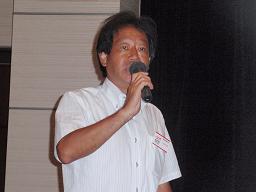
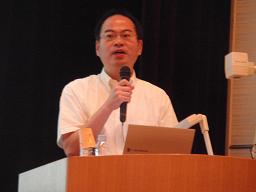
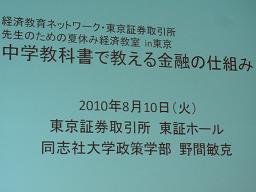
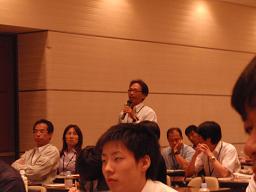
セッション2:企業モデル・シミュレーションの実践:Firm Model-Simulation
13:00-14:40 三枝利多教諭(Mr. Saegusa)による模擬授業と参加者との交流
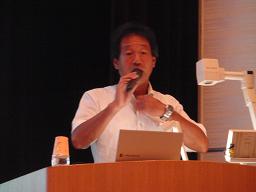
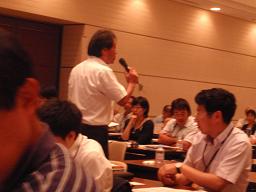
模擬授業に対する栗原久教授(Prof. Kurihara)のコメントとグループ・ディスカッション
14:50-16:30 経済の授業の進め方:How to Teach Economics at Middle School
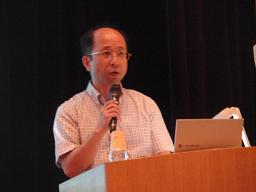
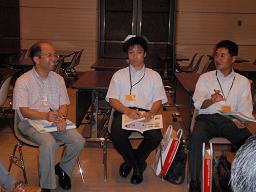
参加者と議論する篠原総一教授(Prof. Shinohara)および加藤一誠教授(Prof. Kato)

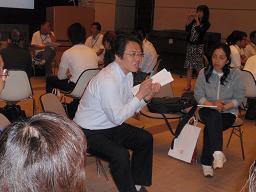
参加者と質疑応答する野間敏克教授(Prof. Noma)および三枝利多教諭(Mr. Saegusa)
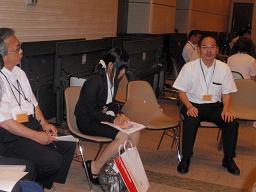
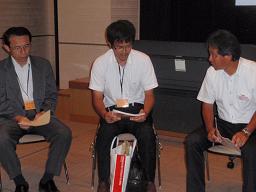
先生のための「夏休み経済教室」(2日目)内容要旨:
8月10日に東証ホールで「中高校教員のための経済教室」の2日目が開催された。
まず総合司会の三枝利多教諭(目黒中央中学)の簡単な開会挨拶の後、野間敏克教授(同志社大)が、「教科書で教える金融の仕組み」についてプレゼンを行った。そこでは、カネの貸し借りが貸し手と借り手の両方の満足度を高めることが強調された。その上で、直接金融と間接金融の説明がなされ、日本では金融のほとんどが間接金融で、直接金融はわずかである事実が指摘された。さらに、金融市場における利子率の決定、また株式市場におけるバブル発生の可能性についての説明があった。そして最後に、日本の貨幣や金融のマクロ的な全体像が示され、金融問題に対処するための金融政策が取り上げられた。
次のセッションでは、三枝教諭が、「企業モデル・シミュレーションの実践」と題する模擬授業を行い、ハウスメーカーの例を取り上げて、企業が他の企業と直接的あるいは間接的に市場で交流するために、会社内にさまざまな仕事や職種が存在することを示した。ここでの基本的なアプローチは、一日目に篠原教授が提示した企業モデルによっているといえる。
その三枝氏のプレゼンに対して、栗原久教授(信州大学)がコメントし、企業もモデル・シミュレーションは学ぶモティベーションを与える上で有益な手段であるが、重要なのは、そのような手段で達成すべき学習目的を明確にすることであると述べた。
以上のプレゼンのセッションの後、グループ・ディスカッションが行われ、篠原総一教授、野間敏克教授、栗原久教授、加藤一誠教授、それに三枝利多教諭を加えた5人が、中学生に経済学をどう教えたらいいかという参加者の質問に答える側に回った。
この2日間の経済教室は、経済学そのものをもっと知りたい、また経済学を教室で生徒たちにより分かりやすく教えたいと望む先生方には、非常に有用な内容であったと思われる。
Summertime Economic Seminar for Teachers (Middle School) – Day 2 Summary:
On the second day of the seminar (8/10), after a brief introduction by Mr. Toshikazu Saegusa (Meguro Chuo Middle School) as the moderator, Prof. Toshikatsu Noma (Doshisha University) gave a talk on the “Mechanism of Finance in Textbooks,” where he first emphasized that money lending and borrowing would generally increase the level of satisfaction for both the lender and the borrower. Then he explained about direct and indirect financing, and pointed out the fact that in Japan indirect financing is dominant, probably too dominant, compared to direct financing. Also discussed were how the interest rate is determined in the financial market and how the bubble can be created in the stock market. Prof. Noma concluded his talk by discussing the macro picture of money and finance as well as monetary policy to deal with financial problems in the economy.
In the next session, Mr. Saegusa made a presentation on the “Practice of the Simulation Model of the Firm,” where a house maker model is used to show various tasks and positions in the firm, interacting with other firms directly or indirectly in the market. The basic approach is based on the firm model presented by Prof. Shinohara on the first day of the seminar.
Then, Prof. Hisashi Kurihara (Shinshu University) commented on Mr. Saegusa’s presentation, saying that his simulation model should be a useful tool to motivate students to learn economics, but the important thing is to clarify teaching objectives to achieve by using such a tool.
After the presentation sessions, group discussions took place, where Professors Soichi Shinohara, Toshikatu Noma, Kazusei Kato and Hisashi Kurihara, joined by Mr. Saegusa, answered participants’ questions as to how to teach economics to middle school students.
The two-day seminar should be useful for middle school teachers who would like to learn about economics itself as well as how to teach economics to their students effectively in classrooms.
"Summertime Economic Seminar for Teachers" @Tokyo (Middle School): Day 2
場所:東京証券取引所・東証ホール; Place: Tokyo Stock Exchange, Tosho Hall
参加者:中学の教員を中心に100名以上; Participants: More than 100 teachers
プログラム: Program:
セッション1:教科書で教える金融の仕組み:Mechanism of Finance in Textbooks
10:00-12:00 司会三枝利多教諭(Mr. Saegusa)と野間敏克教授(Prof. Noma)の講演




セッション2:企業モデル・シミュレーションの実践:Firm Model-Simulation
13:00-14:40 三枝利多教諭(Mr. Saegusa)による模擬授業と参加者との交流


模擬授業に対する栗原久教授(Prof. Kurihara)のコメントとグループ・ディスカッション
14:50-16:30 経済の授業の進め方:How to Teach Economics at Middle School


参加者と議論する篠原総一教授(Prof. Shinohara)および加藤一誠教授(Prof. Kato)


参加者と質疑応答する野間敏克教授(Prof. Noma)および三枝利多教諭(Mr. Saegusa)


先生のための「夏休み経済教室」(2日目)内容要旨:
8月10日に東証ホールで「中高校教員のための経済教室」の2日目が開催された。
まず総合司会の三枝利多教諭(目黒中央中学)の簡単な開会挨拶の後、野間敏克教授(同志社大)が、「教科書で教える金融の仕組み」についてプレゼンを行った。そこでは、カネの貸し借りが貸し手と借り手の両方の満足度を高めることが強調された。その上で、直接金融と間接金融の説明がなされ、日本では金融のほとんどが間接金融で、直接金融はわずかである事実が指摘された。さらに、金融市場における利子率の決定、また株式市場におけるバブル発生の可能性についての説明があった。そして最後に、日本の貨幣や金融のマクロ的な全体像が示され、金融問題に対処するための金融政策が取り上げられた。
次のセッションでは、三枝教諭が、「企業モデル・シミュレーションの実践」と題する模擬授業を行い、ハウスメーカーの例を取り上げて、企業が他の企業と直接的あるいは間接的に市場で交流するために、会社内にさまざまな仕事や職種が存在することを示した。ここでの基本的なアプローチは、一日目に篠原教授が提示した企業モデルによっているといえる。
その三枝氏のプレゼンに対して、栗原久教授(信州大学)がコメントし、企業もモデル・シミュレーションは学ぶモティベーションを与える上で有益な手段であるが、重要なのは、そのような手段で達成すべき学習目的を明確にすることであると述べた。
以上のプレゼンのセッションの後、グループ・ディスカッションが行われ、篠原総一教授、野間敏克教授、栗原久教授、加藤一誠教授、それに三枝利多教諭を加えた5人が、中学生に経済学をどう教えたらいいかという参加者の質問に答える側に回った。
この2日間の経済教室は、経済学そのものをもっと知りたい、また経済学を教室で生徒たちにより分かりやすく教えたいと望む先生方には、非常に有用な内容であったと思われる。
Summertime Economic Seminar for Teachers (Middle School) – Day 2 Summary:
On the second day of the seminar (8/10), after a brief introduction by Mr. Toshikazu Saegusa (Meguro Chuo Middle School) as the moderator, Prof. Toshikatsu Noma (Doshisha University) gave a talk on the “Mechanism of Finance in Textbooks,” where he first emphasized that money lending and borrowing would generally increase the level of satisfaction for both the lender and the borrower. Then he explained about direct and indirect financing, and pointed out the fact that in Japan indirect financing is dominant, probably too dominant, compared to direct financing. Also discussed were how the interest rate is determined in the financial market and how the bubble can be created in the stock market. Prof. Noma concluded his talk by discussing the macro picture of money and finance as well as monetary policy to deal with financial problems in the economy.
In the next session, Mr. Saegusa made a presentation on the “Practice of the Simulation Model of the Firm,” where a house maker model is used to show various tasks and positions in the firm, interacting with other firms directly or indirectly in the market. The basic approach is based on the firm model presented by Prof. Shinohara on the first day of the seminar.
Then, Prof. Hisashi Kurihara (Shinshu University) commented on Mr. Saegusa’s presentation, saying that his simulation model should be a useful tool to motivate students to learn economics, but the important thing is to clarify teaching objectives to achieve by using such a tool.
After the presentation sessions, group discussions took place, where Professors Soichi Shinohara, Toshikatu Noma, Kazusei Kato and Hisashi Kurihara, joined by Mr. Saegusa, answered participants’ questions as to how to teach economics to middle school students.
The two-day seminar should be useful for middle school teachers who would like to learn about economics itself as well as how to teach economics to their students effectively in classrooms.
2010-08-10 22:21
コメント(0)
トラックバック(0)




コメント 0
コメントの受付は締め切りました